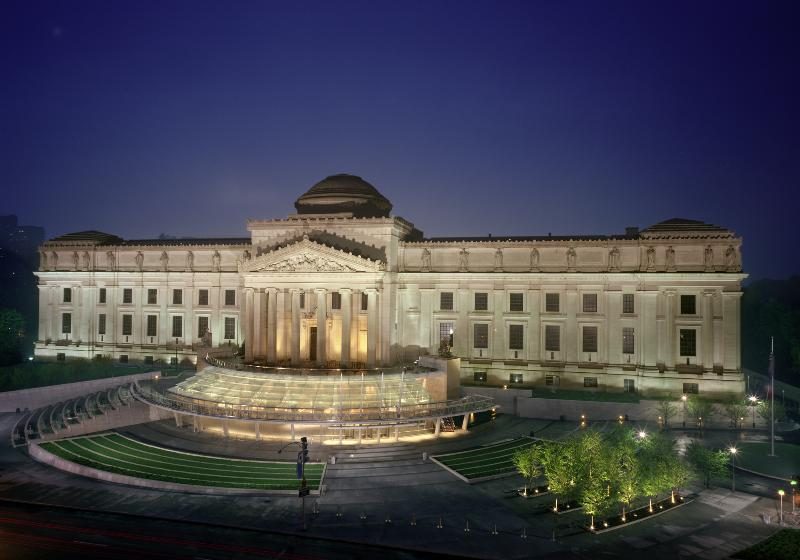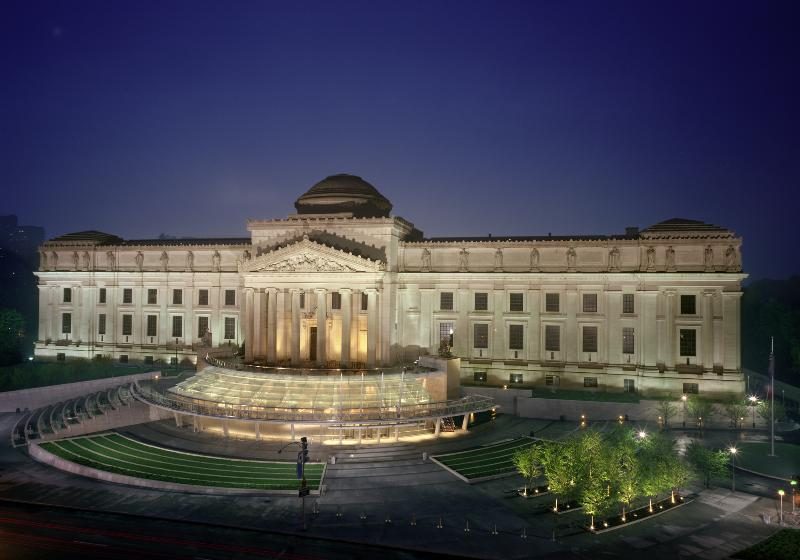[ad_1]

The Brooklyn Museum.
COURTESY BROOKLYN MUSEUM
The Brooklyn Museum’s decision to hire a white woman, Kristen Windmuller-Luna, as its consulting curator for African art has generated debate about representation in museums, with some saying that the job should have gone to a person of color.
Now Decolonize This Place, an activist group dedicated to “indigenous struggle, black liberation, Free Palestine, global wage workers, and de-gentrification,” has released an open letter regarding Windmuller-Luna’s hiring. Titled “Your Curatorial Crisis Is an Opportunity to Decolonize,” the letter, which was posted to the blog Decolonize Brooklyn Museum, demands that the museum do more to address the controversy surrounding the news. The group offers a solution: the formation of what it calls a “Decolonization Commission,” which would help the museum “account for [its] own role in the histories of colonialism and white supremacy.”
The letter goes on to note that the Brooklyn Museum’s choice to hire a white curator for its African art department “reflects deeper structural flaws within this museum’s culture in particular and in the field, more generally. . . . We believe that this moment presents an opportunity for the museum to review — and fully acknowledge — its fraught history of acquisition, exhibition, staffing, and self-presentation with a view to reconstructing its operations, both internal and public-facing.”
Reactions to the news of Windmuller-Luna’s appointment have been passionate and varied. Last week, a widely shared tweet by Business Insider’s Emmanuel Ocbazghi compared the news to a sequence in the recent film Black Panther involving a black man visiting a British Museum gallery featuring plundered African artworks. In an op-ed published by the Guardian yesterday, the poet Teju Adisa-Farrar wrote of the hire, “I’m not surprised, but still mad.”
Others have also argued that the Brooklyn Museum is being wrongly criticized over an issue that is structural. “The outrage around Brooklyn revolves around public misconceptions . . . that African art scholars and curators are largely people of color,” Steven Nelson, a professor of African and African American art history at the University of California, Los Angeles, said in a Newsweek story. “Yet the field of African art history in the U.S. is largely white and female. I am one of a small handful of African Americans who specialize in African art history.” Nelson, who knows Windmuller-Luna, called her “richly deserving of the Brooklyn position.”
And on Twitter, the writer and curator Kimberly Drew made a similar point, noting, “A lot of non-black people study African Art,” and adding that “84 percent of curatorial positions are held by white people. This is the actual problem.”
The museum has defended its decision to hire Windmuller-Luna. “We are committed to equity in all that we do,” the museum said in a statement posted to its Twitter on March 29. (ARTnews reached out to the Brooklyn Museum for a comment regarding the Decolonize This Place letter. The museum said it plans to issue a statement. This post will be updated with any comment.)
Decolonize This Place’s letter follows in full below, along with a list of organizations and coalitions that have endorsed their statement.
We don’t know all of the factors that went into the decision of Anne Pasternak and others to appoint a white woman (Kristen Windmuller-Luna) as the new chief curator of the Brooklyn Museum’s African collection. But no matter how one parses it, the appointment is simply not a good look in this day and age–especially on the part of a museum that prides itself on its relationships with the diverse communities of Brooklyn. What we have heard expressed is a sense of surprise, on the one hand, that this museum of all museums would make such a tone-deaf decision, and, on the other, the realization that the decision is not a surprise at all given the pervasive structures of white supremacy in the art field. So, what will the Brooklyn Museum do now?
We expect the museum to take extraordinary measures to address the public concern surrounding this specific hiring decision, and, in doing so, to resist falling back on the default criterion of Ivy-League expertise that by its very nature is biased towards white scholars. But we also believe that the current crisis calls for a more wide-ranging, structural response. We are thus calling for the Brooklyn Museum to participate in the creation of a Decolonization Commission of the kind that has recently been demanded of institutions — like the city’s own American Museum of Natural History — that are being publicly asked to account for their own role in the histories of colonialism and white supremacy. This would send a strong message to the people of Brooklyn, and to other art institutions around the country, about the museum’s will to redress ongoing legacies of oppression, especially when it comes to the status of African art and culture. It could be a first step in rebuilding trust with the communities to whom the museum should be accountable.
The gathering crisis cannot be confined to rectifying a single misstep in recruitment. It reflects deeper structural flaws within this museum’s culture in particular and in the field, more generally. Museum officials need to look beyond demographic diversification per se, notwithstanding the dismal rates of representation of Black people and other communities of color in higher-rank positions within cultural institutions. Ultimately, the situation calls for a decolonial approach that goes to the root and branch of the museum’s institutional culture and sense of historical mission. Why are colonial legacies still informing its fundamental operations? A time of reckoning with these legacies is long overdue, along with a willingness to embrace new modes of accountability.
The hue and cry over this hire has brought to light a major disconnect between the governance of the museum and the communities of Brooklyn whom the institution is obliged to serve. Unlike other city museums that are more unabashed in catering to the global tourist trade, the Brooklyn Museum has recently provided evidence of a desire to live up to these obligations. Last year, Rujeko Hockley and Catherine Morris of the Elizabeth Sackler Center for Feminist Art mounted the groundbreaking exhibition We Wanted a Revolution: Black Radical Women, 1965-1985. What if the spirit of this extraordinary show was extended to inform the actual structure and governance of the museum itself? The resulting changes in the institutional culture would not only be welcome in their own right, but they would also most certainly preempt any repeat of the current debacle, where the museum is expending time and energy doing damage-control around the bad optics of hiring a white woman to curate the African collection.
But shows like We Wanted a Revolution are the exception to the rule, and the current commotion around the Africanist hire is only the latest controversy about the disjunct between the institution and the public on its doorstep. In 2016, the museum mounted the exhibition Agitprop!, devoted to radical art and activism over the past century. At the very same time, it was playing host to the Brooklyn Real Estate Summit, at which leading property corporations strategized about how to best identify new frontiers of investment in the borough. The President and Chief Operating Officer of the museum is David Berliner, a top executive at Forest Ratner, notorious for the Atlantic Yards project which kicked off the intensive gentrification of downtown Brooklyn in the early 2000s. The museum also provided cover for pro-Israeli artwashing in the exhibition of the lavishly-funded This Place photography show. In fact, it was the conjunction of these two examples of artwashing that inspired the formation of Decolonize this Place, an arts-activist collective that has focused much of its energies on actions devoted to the decolonial overhaul of New York City museums.
The analysis and practice developed in these actions suggests a more comprehensive response to the clamor surrounding the museum’s curatorial hire. We believe that this moment presents an opportunity for the museum to review — and fully acknowledge — its fraught history of acquisition, exhibition, staffing, and self-presentation with a view to reconstructing its operations, both internal and public-facing. We have presented the American Museum of Natural History with a similar proposition, following the Anti-Columbus Day Tours of 2016 and 2017, and in the recent campaign to remove odious public monuments, including the Theodore Roosevelt statue that disgraces its entrance.
This decolonization process would have a time-frame, starting with the acknowledgment that the buildings sit on stolen indigenous land, that they contain thousands of objects expropriated from people of color around the world, and that the institution is governed by a group of majority-white members of the 1% actively involved in the dynamics of racialized dispossession and displacement in Brooklyn. Further steps would entail decisions about the framing of the display of its collection; who is appointed to make these decisions, and in consultation with which communities of conscience in the borough and beyond. Decolonization is never a finished process, but, once undertaken, its logic can and should unfold in ways that are transparent and just.
No doubt, museum officials will be apprehensive about this larger proposition–the leadership of the American Museum of Natural History appears to have adopted a siege mentality in response–and yet there is every reason to grasp the opportunity to embrace it. The Brooklyn Museum can turn this loss of face into a far-reaching commitment to make museological history in a borough heralded — worldwide — for its innovative initiatives and ethos of inclusion.
In this spirit, we propose the following:
The Decolonization Commission, which will include local stakeholders, would explore:
1) Territorial Acknowledgement of Indigenous land occupied by its buildings and giving material effect to such an acknowledgment in curatorial practices, programming, exhibitions, and day-to-day operations.
2) The deep diversification of curatorial staff and executive leadership whereby the lived experience of oppressions — including patriarchy, white supremacy, and poverty — are valued and factored in.
3) A decolonial inventory of colonial-era objects of both African and Indigenous people with a view to settling the long-pursued claims of reparations and repatriation.
4) An upgrade of working conditions and pay of ground staff — who are disproportionately employees of color — in security, food service, and janitorial divisions.
5) The replacement of Board president David Berliner and other trustees who are real estate tycoons with a broad cross-section of artists and community organizers.
5) The undertaking of a de-gentrification initiative to examine and mitigate the museum’s role in boosting land value and rents in the borough.
6) An institutional commitment to address the issues raised by the Boycott, Divestment, and Sanctions (BDS) movement in recognition of the debate among Brooklynites about the central role played by segments of the borough’s population in the settler movement in Palestine.
Initiated by:
Decolonize This Place
And supported by:
Brooklyn Anti-Gentrification Network (BAN)
Flower Lovers Against Corruption (FLAC)
Equality for Flatbush (E4F)
Movement to Protect the People (MTOPP)
Mi Casa No Es Su Casa: Illumination Against Gentrification
NYC Stands with Standing Rock
Black Youth Project 100
Chinatown Art Brigade
Bronx Social Center
Take Back The Bronx
Free University
If you and/or your organization would like to endorse this call to the Brooklyn Museum, please write us at [email protected].
[ad_2]
Source link

